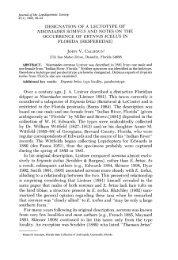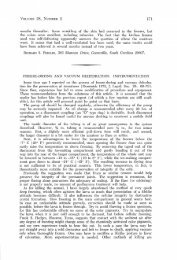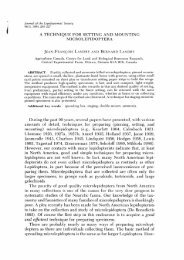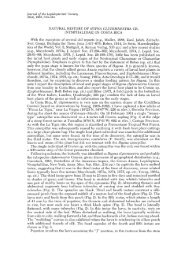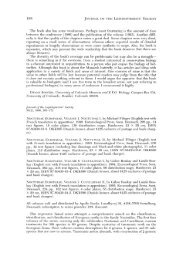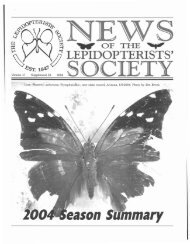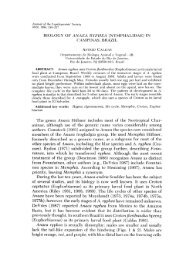Notes on the life cycle and natural history of butterflies of El Salvador ...
Notes on the life cycle and natural history of butterflies of El Salvador ...
Notes on the life cycle and natural history of butterflies of El Salvador ...
You also want an ePaper? Increase the reach of your titles
YUMPU automatically turns print PDFs into web optimized ePapers that Google loves.
VOLUME 28, NUMBER 4 313<br />
lay <strong>the</strong>ir eggs <strong>on</strong> <strong>the</strong> leaf where <strong>the</strong> larvae are feeding. The amount <strong>of</strong><br />
larvae killed by Tachinidae, in our experience, reaches an estimated 40%.<br />
The tachinid larvae usually ab<strong>and</strong><strong>on</strong> <strong>the</strong> victim during <strong>the</strong> fifth stadium<br />
or just after pupati<strong>on</strong>.<br />
The adults <strong>of</strong> A. (M.) e. c<strong>on</strong>fusa also exhibit a combined defense<br />
mechanism: rapid flight with flash-<strong>and</strong>-hide effect, caused by <strong>the</strong> orange<br />
colorati<strong>on</strong> <strong>on</strong> <strong>the</strong> dorsal surface <strong>of</strong> <strong>the</strong> wings <strong>and</strong> <strong>the</strong> cryptic grayishbrown<br />
colorati<strong>on</strong> <strong>on</strong> <strong>the</strong> ventral side; <strong>and</strong> this cryptic colorati<strong>on</strong> that<br />
mimics <strong>the</strong> color <strong>of</strong> a dry leaf, rendering <strong>the</strong> adults very inc<strong>on</strong>spicuous<br />
am<strong>on</strong>g vegetati<strong>on</strong> (or when <strong>the</strong>y are sitting <strong>on</strong> surfaces such as tree<br />
trunks, where <strong>the</strong>y even adopt a slanted positi<strong>on</strong> to minimize <strong>the</strong> shadow<br />
<strong>the</strong>y project, according to <strong>the</strong> sun situati<strong>on</strong>). The <strong>on</strong>ly time adults are<br />
vulnerable to predati<strong>on</strong> (if <strong>the</strong>y are not protected by unpalatable properties,<br />
as we str<strong>on</strong>gly suspect), is during <strong>the</strong>ir feeding sessi<strong>on</strong>s, when<br />
<strong>the</strong>y seem to get so engorged as to lose <strong>the</strong>ir habitual alertness.<br />
Taking as a basis <strong>the</strong> developmental time <strong>of</strong> 40-45 days under laboratory<br />
c<strong>on</strong>diti<strong>on</strong>s, this species could produce about eight generati<strong>on</strong>s a<br />
year due to <strong>the</strong> fact that <strong>the</strong> foodplant remains well covered by succulent<br />
leaves <strong>the</strong> year around. In fact adults <strong>and</strong> larvae <strong>of</strong> <strong>the</strong> species can be<br />
collected at any time <strong>of</strong> <strong>the</strong> year.<br />
A very vulnerable stage in <strong>the</strong> <strong>life</strong> <strong>cycle</strong> <strong>of</strong> this species appears to be<br />
<strong>the</strong> egg stage. For some undetermined reas<strong>on</strong> a c<strong>on</strong>siderable number<br />
<strong>of</strong> eggs never hatch, <strong>and</strong> some <strong>of</strong> <strong>the</strong>m produce a tiny Chalcidoidea<br />
(which has been sent to <strong>the</strong> U.S. Dept. <strong>of</strong> Agriculture for determinati<strong>on</strong>).<br />
As said for Prep<strong>on</strong>a omphale octavia (M uysh<strong>on</strong>dt, 1973), this is <strong>on</strong>e<br />
<strong>of</strong> <strong>the</strong> few species <strong>of</strong> Rhopalocera that has derived benefits from manmade<br />
changes in <strong>the</strong> <strong>natural</strong> ecology, i.e. by <strong>the</strong> agumentati<strong>on</strong> <strong>of</strong> <strong>the</strong><br />
foodplant in c<strong>of</strong>fee plantati<strong>on</strong>s.<br />
ACKNOWLEDGMENTS<br />
We are greatly indebted to Miguel Serrano <strong>and</strong> Stephen Steinhauser<br />
for sharing with us <strong>the</strong>ir pers<strong>on</strong>al observati<strong>on</strong>s <strong>on</strong> <strong>the</strong> adults <strong>of</strong> this<br />
species <strong>and</strong> for giving us free access to <strong>the</strong>ir technical libraries; <strong>and</strong> to<br />
Drs. Lee D. Miller <strong>and</strong> Theodore D. Sargent for finding time in <strong>the</strong>ir<br />
crowded schedules to read <strong>the</strong> manuscripts <strong>and</strong> give c<strong>on</strong>structive criticism.<br />
Special menti<strong>on</strong> must go to <strong>the</strong> enthusiasm <strong>of</strong> Albert, Jr. <strong>and</strong> Pierre,<br />
two members <strong>of</strong> <strong>the</strong> family, who have made most <strong>of</strong> <strong>the</strong> findings <strong>on</strong> <strong>the</strong><br />
early stages <strong>of</strong> this species. Specimens <strong>of</strong> <strong>the</strong> early stages have been<br />
sent to Allyn Museum <strong>of</strong> Entomology.





